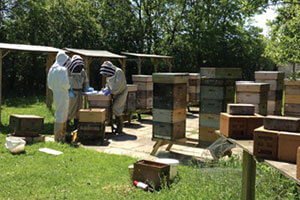
With this month’s installment of my meandering natural history of the honey bee we arrive at a topic that is near and dear to my heart – the queen’s habit of mating with multiple males, storing their sperm in an organ called the spermatheca, and using the sperm to fertilize her life’s output of eggs. This behavior is called polyandry. I attach such importance to polyandry not just because of its importance to the evolution of Apis mellifera, but also because of its up-to-the-hour relevance for the health problems facing honey bees today. Well, and to be honest, it was also the subject of my research sabbatical in England in 2012-2013 – a period of my life dense with happy memories not the least of which were the delightful cross-country footpaths and the famously fortifying real ales awaiting the road-weary walker at each village pub.
My sabbatical host was Dr. Giles Budge at the National Bee Unit, a section of the UK’s Food and Environment Research Agency (FERA) housed near the ancient northern city of York (see Figure). Giles and I had become increasingly interested in the booming literature on polyandry and its diverse health benefits for the bee colony. The papers on polyandry were emerging at an escalating rate, and we couldn’t help but wonder if this was another one of those evolutionary clues to good beekeeping management.
But before I can delve into that I want to return a moment to something I talked about last June, and that is how colonies resolve reproductive conflicts among nest mates. I explained how daughters in the primitive nests of our putative ancestral honey bee could choose to leave the nest, strike out on their own, and expect to pass on 50% of their genes in the form of offspring; or they could choose to stay at the nest, altruistically help their mother reproduce, and pass on 50% of their genes in the form of siblings. It is possible that the presence of a nest and the stabilizing benefits of cooperation, shared defense, and shared foraging were powerful rewards for choosing the social route. But readers will recall that just because we can do the math and show equal genetic rewards does not by itself compel workers to the social route. In June I asked, “So what extraordinary selection pressures pushed honey bee workers toward such extreme expressions of cooperation and altruism that they evolved into a sterile and distinct caste?”
One possibility is so-called voluntary altruism. The discovery of genes that do indeed code for altruistic behavior lends support to this option1, and moreover, such genes can be expected to occur at higher-than-background rates in colonies where there’s already a high degree of familial relatedness. However, the presence of altruistic genes does not mean that there’s no possibility for selfishness. After all, even a sterile worker can activate her ovaries and produce sons – a perfectly viable option for passing on 50% of her genes. In a social context, such workers are called “outlaws,” and what makes them selfish is the fact that they cease any work on behalf of the colony while coopting the machinery of the colony to rear their own sons. They become social parasites. If all workers did this the whole colony, and everyone in it, would eventually perish – a genetic dead-end if there ever was one. Nevertheless, theory based on simple inheritance predicts that over 50% of workers can still be expected to choose this selfish option2. So in the end, voluntary altruism, even with the presence of altruistic genes, does not seem capable of explaining such high levels of altruism and social cohesion we see in the modern honey bee colony.
What seems a better answer is enforced altruism, also called …


